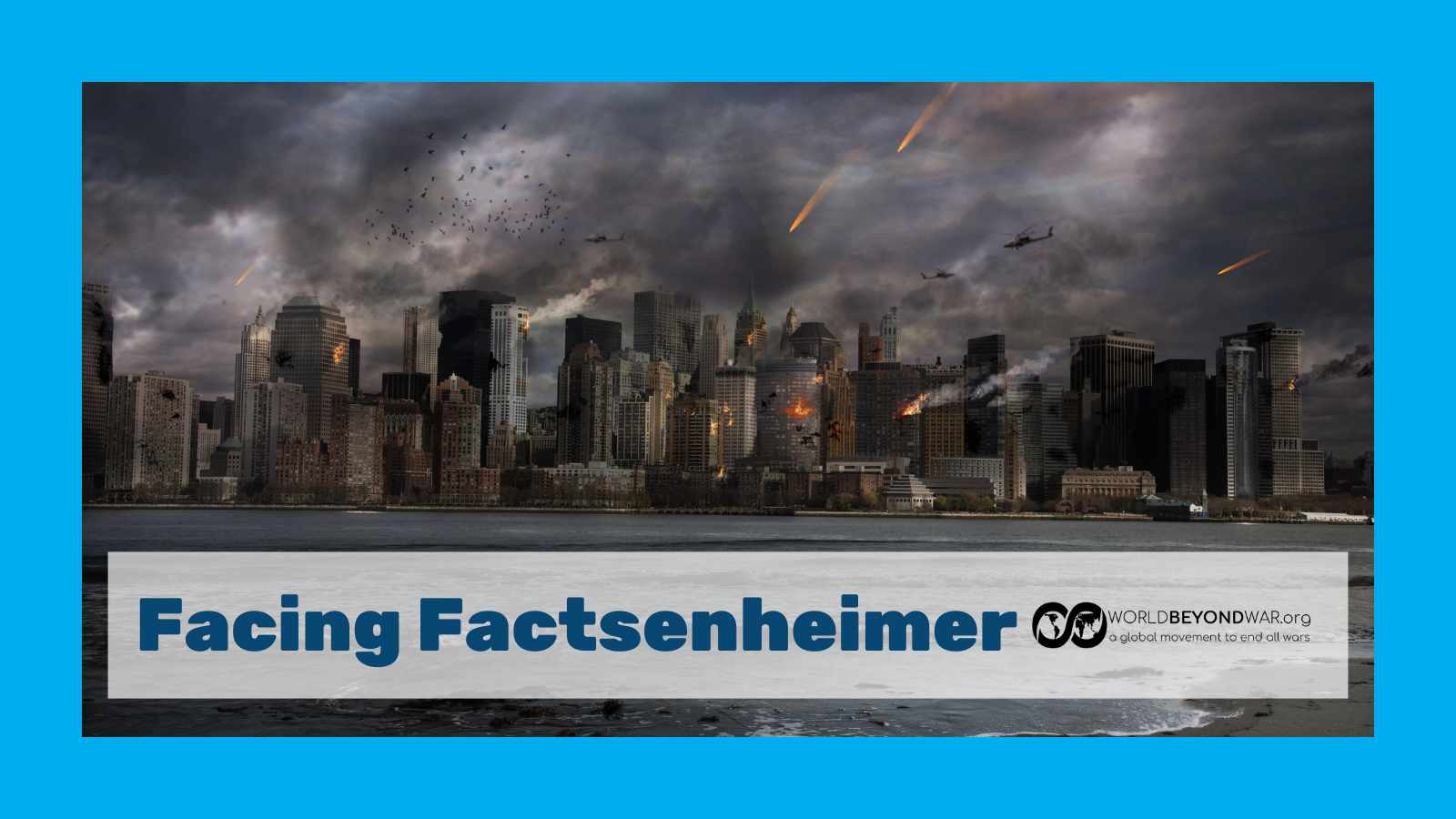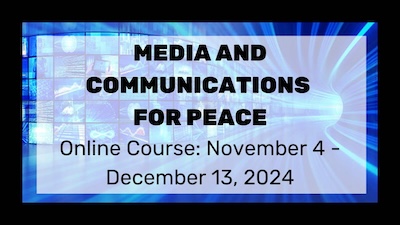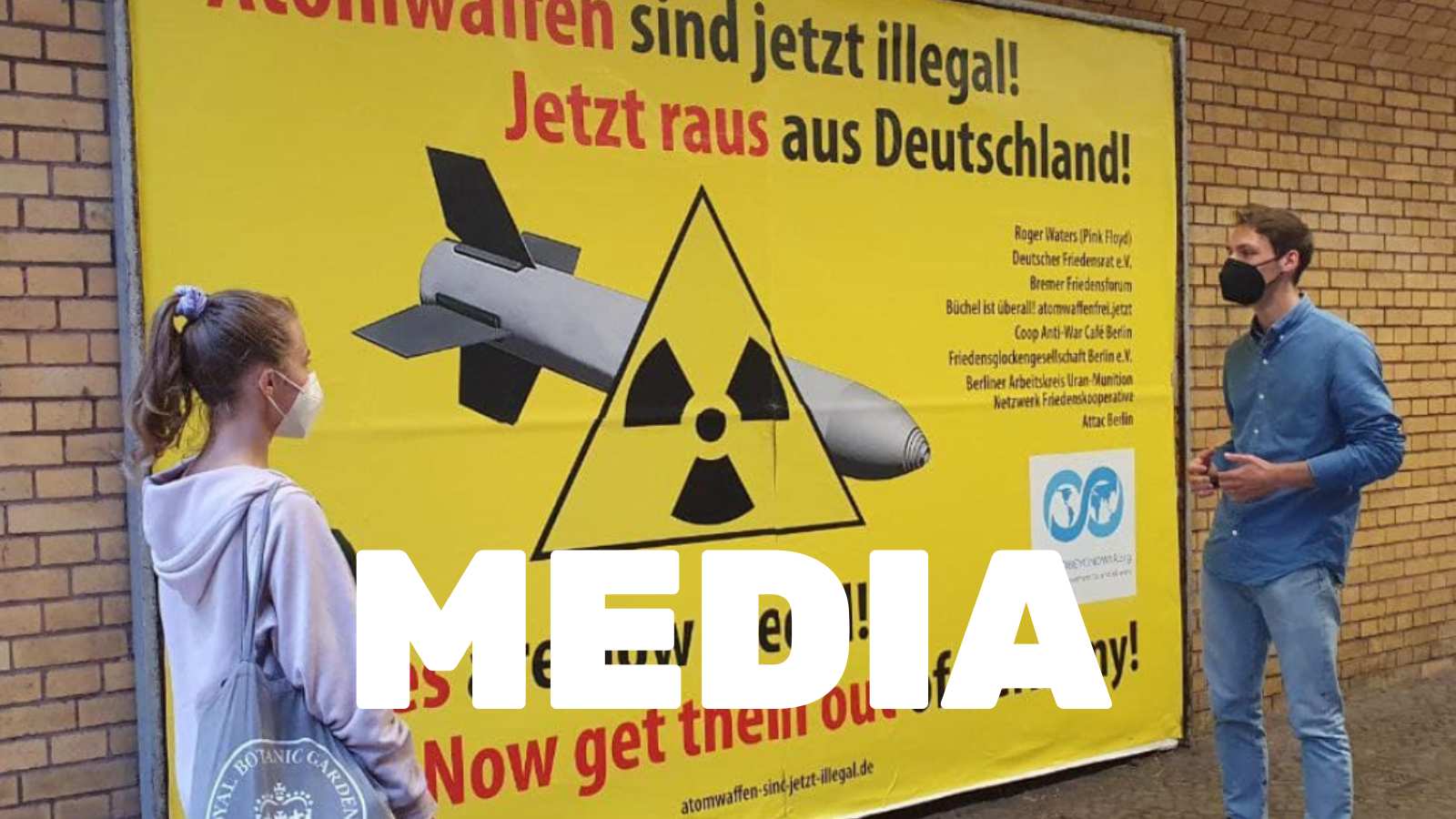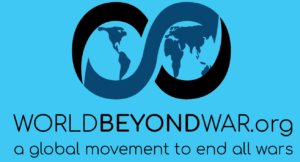
By David Swanson, World BEYOND War, July 22, 2023
I’m rolling down the President Biden “Expressway” in Scranton PA (speed limit 35) listening to Kai Bird’s and Martin Sherwin’s bio of Oppenheimer, and it strikes me that the subject’s decision not to poison every man, woman, and child in Germany, purely because he couldn’t figure out how to do it, probably didn’t make it into the movie. (Tell me if I’m wrong.)
I will be extremely pleasantly surprised if anyone comes out of the movie struck by what a reader of the book (remember those?) ought to be struck by: the Los Alamos scientists were willing to commit mass murder because they were sold a package of lies, and when those lies fell apart, one by one — some before and some after the use of nuclear bombs on two cities — many of those scientists changed their minds. They were told that Germany was probably developing a nuclear bomb and would soon use it. They learned that this was probably not the case. They were told that the war would only end with either Germany or the United States using nuclear bombs. Then Germany surrendered without anybody having used the bomb. They were told that the Soviet Union, that place doing the bulk of the fighting against Germany, was an ally in a struggle for the survival of life on Earth. Then they were told that the Soviet Union was the actual enemy against whom the bomb needed to be developed and brandished. Various of them were given to understand at various points that the bomb technology would be shared internationally to prevent its use or an arms race, or that it would be demonstrated on an uninhabited location or simply communicated to Japan prior to being used on cities. The scientists were told that bombing Japan would be needed to end the war, even as the pressue on them to hurry was increased, with Germany out of the war, and the actual urgency coming from Washington’s desire to use the bombs before the war could end — and end through Soviet action — without the bombs having been demonstrated.
Some of the scientists quit at various points in this saga. Some of them illegally gave information to the Soviets, believing — rightly or wrongly — that doing so would deter usage of nuclear bombs. Some of them lobbied and agitated for global regulation and disarmament. Some of them had regrets. Some of them rationalized. Some of them suffered secret nightmares. Some of them slept soundly and continued right on with making larger bombs.
None of them knew exactly what would happen, whether the atmosphere would catch fire, what nuclear winter was, how long damage would spread, what to do with nuclear waste, or that nuclear energy could be in any way a wise pursuit. None of them had studied the history of false beliefs that new weapons would, by their increased horror, put an end to warfare. None of them had considered what investing a fortune in peace studies and conflict resolution might have achieved in comparison with investing it in the mad pursuit of better killing tools.
Some of the lies the scientists were told have been forgotten. Some we are still told today, these many decades after their exposure. So, lets’ face up to a few facts. The nukes did not save lives. They took lives, possibly 200,000 of them. They were not intended to save lives or to end the war. And they didn’t end the war. The Russian invasion did that. But the war was going to end anyway, without either of those things. The United States Strategic Bombing Survey concluded that, “… certainly prior to 31 December, 1945, and in all probability prior to 1 November, 1945, Japan would have surrendered even if the atomic bombs had not been dropped, even if Russia had not entered the war, and even if no invasion had been planned or contemplated.”
One dissenter who had expressed this same view to the Secretary of War and, by his own account, to President Truman, prior to the bombings was General Dwight Eisenhower. Under Secretary of the Navy Ralph Bard, prior to the bombings, urged that Japan be given a warning. Lewis Strauss, Advisor to the Secretary of the Navy, also prior to the bombings, recommended blowing up a forest rather than a city. General George Marshall apparently agreed with that idea. Atomic scientist Leo Szilard organized scientists to petition the president against using the bomb. Atomic scientist James Franck organized scientists who advocated treating atomic weapons as a civilian policy issue, not just a military decision. Another scientist, Joseph Rotblat, demanded an end to the Manhattan Project, and resigned when it was not ended. A poll of the U.S. scientists who had developed the bombs, taken prior to their use, found that 83% wanted a nuclear bomb publicly demonstrated prior to dropping one on Japan. The U.S. military kept that poll secret. General Douglas MacArthur held a press conference on August 6, 1945, prior to the bombing of Hiroshima, to announce that Japan was already beaten.
The Chairman of the Joint Chiefs of Staff Admiral William D. Leahy said angrily in 1949 that Truman had assured him only military targets would be nuked, not civilians. “The use of this barbarous weapon at Hiroshima and Nagasaki was of no material assistance in our war against Japan. The Japanese were already defeated and ready to surrender,” Leahy said. Top military officials who said just after the war that the Japanese would have quickly surrendered without the nuclear bombings included General Douglas MacArthur, General Henry “Hap” Arnold, General Curtis LeMay, General Carl “Tooey” Spaatz, Admiral Ernest King, Admiral Chester Nimitz, Admiral William “Bull” Halsey, and Brigadier General Carter Clarke. As Oliver Stone and Peter Kuznick summarize, seven of the United States’ eight five-star officers who received their final star in World War II or just after — Generals MacArthur, Eisenhower, and Arnold, and Admirals Leahy, King, Nimitz, and Halsey — in 1945 rejected the idea that the atomic bombs were needed to end the war. “Sadly, though, there is little evidence that they pressed their case with Truman before the fact.”
On August 6, 1945, President Truman lied on the radio that a nuclear bomb had been dropped on an army base, rather than on a city. And he justified it, not as speeding the end of the war, but as revenge against Japanese offenses. “Mr. Truman was jubilant,” wrote Dorothy Day. Weeks before the first bomb was dropped, on July 13, 1945, Japan had sent a telegram to the Soviet Union expressing its desire to surrender and end the war. The United States had broken Japan’s codes and read the telegram. Truman referred in his diary to “the telegram from Jap Emperor asking for peace.” President Truman had been informed through Swiss and Portuguese channels of Japanese peace overtures as early as three months before Hiroshima. Japan objected only to surrendering unconditionally and giving up its emperor, but the United States insisted on those terms until after the bombs fell, at which point it allowed Japan to keep its emperor. So, the desire to drop the bombs may have lengthened the war. The bombs did not shorten the war.
Presidential advisor James Byrnes had told Truman that dropping the bombs would allow the United States to “dictate the terms of ending the war.” Secretary of the Navy James Forrestal wrote in his diary that Byrnes was “most anxious to get the Japanese affair over with before the Russians got in.” Truman wrote in his diary that the Soviets were preparing to march against Japan and “Fini Japs when that comes about.” The Soviet invasion was planned prior to the bombs, not decided by them. The United States had no plans to invade for months, and no plans on the scale to risk the numbers of lives that U.S. school teachers will tell you were saved. The idea that a massive U.S. invasion was imminent and the only alternative to nuking cities, so that nuking cities saved huge numbers of U.S. lives, is a myth. Historians know this, just as they know that George Washington didn’t have wooden teeth or always tell the truth, and Paul Revere didn’t ride alone, and slave-owning Patrick Henry’s speech about liberty was written decades after he died, and Molly Pitcher didn’t exist. But the myths have their own power. Lives, by the way, are not the unique property of U.S. soldiers. Japanese people also had lives.
Truman ordered the bombs dropped, one on Hiroshima on August 6th and another type of bomb, a plutonium bomb, which the military also wanted to test and demonstrate, on Nagasaki on August 9th. The Nagasaki bombing was moved up from the 11th to the 9th to decrease the likelihood of Japan surrendering first. Also on August 9th, the Soviets attacked the Japanese. During the next two weeks, the Soviets killed 84,000 Japanese while losing 12,000 of their own soldiers, and the United States continued bombing Japan with non-nuclear weapons — burning Japanese cities, as it had done to so much of Japan prior to August 6th that, when it came time to pick two cities to nuke, there hadn’t been many left to choose from. Then the Japanese surrendered.
That there was cause to use nuclear weapons is a myth. That there could again be cause to use nuclear weapons is a myth. That we can survive significant further use of nuclear weapons is a myth — NOT a “public service announcement.” That there is cause to produce nuclear weapons even though you’ll never use them is too stupid even to be a myth. And that we can forever survive possessing and proliferating nuclear weapons without someone intentionally or accidentally using them is pure insanity.
Why do U.S. history teachers in U.S. elementary schools today — in 2023! — tell children that nuclear bombs were dropped on Japan to save lives — or rather “the bomb” (singular) to avoid mentioning Nagasaki? Researchers and professors have poured over the evidence for 75 years. They know that Truman knew that the war was over, that Japan wanted to surrender, that the Soviet Union was about to invade. They’ve documented all the resistance to the bombing within the U.S. military and government and scientific community, as well as the motivation to test bombs that so much work and expense had gone into, as well as the motivation to intimidate the world and in particular the Soviets, as well as the open and shameless placing of zero value on Japanese lives. How were such powerful myths generated that the facts are treated like skunks at a picnic?
In Greg Mitchell’s 2020 book, The Beginning or the End: How Hollywood — and America — Learned to Stop Worrying and Love the Bomb, we have an account of the making of the 1947 MGM film, The Beginning or the End, which was carefully shaped by the U.S. government to promote falsehoods. The film bombed. It lost money. The ideal for a member of the U.S. public was clearly not to watch a really bad and boring pseudo-documentary with actors playing the scientists and warmongers who had produced a new form of mass-murder. The ideal action was to avoid any thought of the matter. But those who couldn’t avoid it were handed a glossy big-screen myth. You can watch it online for free, and as Mark Twain would have said, it’s worth every penny.
The film opens with what Mitchell describes as giving credit to the UK and Canada for their roles in producing the death machine — supposedly a cynical if falsified means of appealing to a larger market for the movie. But it really appears to be more blaming than crediting. This is an effort to spread the guilt. The film jumps quickly to blaming Germany for an imminent threat of nuking the world if the United States didn’t nuke it first. (You can actually have difficulty today getting young people to believe that Germany had surrendered prior to Hiroshima, or that the U.S. government knew in 1944 that Germany had abandoned atomic bomb research in 1942.) Then an actor doing a bad Einstein impression blames a long list of scientists from all over the world. Then some other personage suggests that the good guys are losing the war and had better hurry up and invent new bombs if they want to win it.
Over and over we’re told that bigger bombs will bring peace and end war. A Franklin Roosevelt impersonator even puts on a Woodrow Wilson act, claiming the atom bomb might end all war (something a surprising number of people actually believe it did, even in the face of the past 75 years of wars, which some U.S. professors describe as the Great Peace). We’re told and shown completely fabricated nonsense, such as that the U.S. dropped leaflets on Hiroshima to warn people (and for 10 days — “That’s 10 days more warning than they gave us at Pearl Harbor,” a character pronounces) and that the Japanese fired at the plane as it approached its target. In reality, the U.S. never dropped a single leaflet on Hiroshima but did — in good SNAFU fashion — drop tons of leaflets on Nagasaki the day after Nagasaki was bombed. Also, the hero of the movie dies from an accident while fiddling with the bomb to get it ready for use — a brave sacrifice for humanity on behalf of the war’s real victims — the members of the U.S. military. The film also claims that the people bombed “will never know what hit them,” despite the film makers knowing of the agonizing suffering of those who died slowly.
One communication from the movie makers to their consultant and editor, General Leslie Groves, included these words: “Any implication tending to make the Army look foolish will be eliminated.”
The main reason the movie is deadly boring, I think, is not that movies have sped up their action sequences every year for 75 years, added color, and devised all kinds of shock devices, but simply that the reason anybody should think the bomb that the characters all talk about for the entire length of the film is a big deal is left out. We don’t see what it does, not from the ground, only from the sky.
Mitchell’s book is a bit like watching sausage made, but also a bit like reading the transcripts from a committee that cobbled together some section of the Bible. This is an origin myth of the Global Policeman in the making. And it’s ugly. It’s even tragic. The very idea for the film came from a scientist who wanted people to understand the danger, not glorify the destruction. This scientist wrote to Donna Reed, that nice lady who gets married to Jimmy Stewart in It’s a Wonderful Life, and she got the ball rolling. Then it rolled around an oozing wound for 15 months and voilà, a cinematic turd emerged.
There was never any question of telling the truth. It’s a movie. You make stuff up. And you make it all up in one direction. The script for this movie contained at times all sorts of nonsense that didn’t last, such as the Nazis giving the Japanese the atomic bomb — and the Japanese setting up a laboratory for Nazi scientists, exactly as back in the real world at this very time the U.S. military was setting up laboratories for Nazi scientists (not to mention making use of Japanese scientists). None of this is more ludicrous than The Man in the High Castle, to take a recent example of 75 years of this stuff, but this was early, this was seminal. Nonsense that didn’t make it into this film, everybody didn’t end up believing and teaching to students for decades, but easily could have. The movie makers gave final editing control to the U.S. military and the White House, and not to the scientists who had qualms. Many good bits as well as crazy bits were temporarily in the script, but excised for the sake of proper propaganda.
If it’s any consolation, it could have been worse. Paramount was in a nuclear arms film race with MGM and employed Ayn Rand to draft the hyper-patriotic-capitalist script. Her closing line was “Man can harness the universe — but nobody can harness man.” Fortunately for all of us, it didn’t work out. Unfortunately, despite John Hersey’s A Bell for Adano being a better movie than The Beginning or the End, his best-selling book on Hiroshima didn’t appeal to any studios as a good story for movie production. Unfortunately, Dr. Strangelove would not appear until 1964, by which point many were ready to question future use of “the bomb” but not past use, making all questioning of future use rather weak. This relationship to nuclear weapons parallels that to wars in general. The U.S. public can question all future wars, and even those wars it’s heard of from the past 75 years, but not WWII, rendering all questioning of future wars weak. In fact, recent polling finds horrific willingness to support future nuclear war by the U.S. public.
At the time The Beginning or the End was being scripted and filmed, the U.S. government was seizing and hiding away every scrap it could find of actual photographic or filmed documentation of the bomb sites. Henry Stimson was having his Colin Powell moment, being pushed forward to publicly make the case in writing for having dropped the bombs. More bombs were rapidly being built and developed, and whole populations evicted from their island homes, lied to, and used as props for newsreels in which they are depicted as happy participants in their destruction.
Mitchell writes that one reason Hollywood deferred to the military was in order to use its airplanes, etc., in the production, as well as in order to use the real names of characters in the story. I find it very hard to believe these factors were terribly important. With the unlimited budget it was dumping into this thing — including paying the people it was giving veto power to — MGM could have created its own quite unimpressive props and its own mushroom cloud. It’s fun to fantasize that someday those who oppose mass murder could take over something like the unique building of the U.S. Institute of “Peace” and require that Hollywood meet peace movement standards in order to film there. But of course the peace movement has no money, Hollywood has no interest, and any building can be simulated elsewhere. Hiroshima could have been simulated elsewhere, and in the movie wasn’t shown at all. The main problem here was ideology and habits of subservience.
There were reasons to fear the government. The FBI was spying on people involved, including wishy-washy scientists like J. Robert Oppenheimer who kept consulting on the film, lamenting its awfulness, but never daring to oppose it. A new Red Scare was just kicking in. The powerful were exercising their power through the usual variety of means.
As the production of The Beginning or the End winds toward completion, it builds the same momentum the bomb did. After so many scripts and bills and revisions, and so much work and ass-kissing, there was no way the studio wouldn’t release it. When it finally came out, the audiences were small and the reviews mixed. The New York daily PM found the film “reassuring,” which I think was the basic point. Mission accomplished.
Mitchell’s conclusion is that the Hiroshima bomb was a “first strike,” and that the United States should abolish its first-strike policy. But of course it was no such thing. It was an only strike, a first-and-last strike. There were no other nuclear bombs that would come flying back as a “second strike.” Now, today, the danger is of accidental as much as intentional use, whether first, second, or third, and the need is to at long last join the bulk of the world’s governments that are seeking to abolish nuclear weapons all together — which, of course, sounds crazy to anyone who has internalized the mythology of WWII.
There are far better works of art than The Beginning or the End that we could turn to for myth busting. For example, The Golden Age, a novel published by Gore Vidal in 2000 with glowing endorsements by the Washington Post, and New York Times Book Review, has never been made into a movie, but tells a story much closer to the truth. In The Golden Age, we follow along behind all the closed doors, as the British push for U.S. involvement in World War II, as President Roosevelt makes a commitment to Prime Minister Churchill, as the warmongers manipulate the Republican convention to make sure that both parties nominate candidates in 1940 ready to campaign on peace while planning war, as Roosevelt longs to run for an unprecedented third term as a wartime president but must content himself with beginning a draft and campaigning as a drafttime president in a time of supposed national danger, and as Roosevelt works to provoke Japan into attacking on his desired schedule.
Then there’s historian and WWII veteran Howard Zinn’s 2010 book, The Bomb. Zinn describes the U.S. military making its first use of napalm by dropping it all over a French town, burning anyone and anything it touched. Zinn was in one of the planes, taking part in this horrendous crime. In mid-April 1945, the war in Europe was essentially over. Everyone knew it was ending. There was no military reason (if that’s not an oxymoron) to attack the Germans stationed near Royan, France, much less to burn the French men, women, and children in the town to death. The British had already destroyed the town in January, similarly bombing it because of its vicinity to German troops, in what was widely called a tragic mistake. This tragic mistake was rationalized as an inevitable part of war, just as were the horrific firebombings that successfully reached German targets, just as was the later bombing of Royan with napalm. Zinn blames the Supreme Allied Command for seeking to add a “victory” in the final weeks of a war already won. He blames the local military commanders’ ambitions. He blames the American Air Force’s desire to test a new weapon. And he blames everyone involved — which must include himself — for “the most powerful motive of all: the habit of obedience, the universal teaching of all cultures, not to get out of line, not even to think about that which one has not been assigned to think about, the negative motive of not having either a reason or a will to intercede.”
When Zinn returned from the war in Europe, he expected to be sent to the war in the Pacific, until he saw and rejoiced at seeing the news of the atomic bomb dropped on Hiroshima. Only years later did Zinn come to understand the inexcusable crime of enormous proportions that was the dropping of nuclear bombs in Japan, actions similar in some ways to the final bombing of Royan. The war with Japan was already over, the Japanese seeking peace and willing to surrender. Japan asked only that it be permitted to keep its emperor, a request that was later granted. But, like napalm, the nuclear bombs were weapons that needed testing.
Zinn also goes back to dismantle the mythical reasons the United States was in the war to begin with. The United States, England, and France were imperial powers supporting each other’s international aggressions in places like the Philippines. They opposed the same from Germany and Japan, but not aggression itself. Most of America’s tin and rubber came from the Southwest Pacific. The United States made clear for years its lack of concern for the Jews being attacked in Germany. It also demonstrated its lack of opposition to racism through its treatment of African Americans and Japanese Americans. Franklin Roosevelt described fascist bombing campaigns over civilian areas as “inhuman barbarity” but then did the same on a much larger scale to German cities, which was followed up by the destruction on an unprecedented scale of Hiroshima and Nagasaki — actions that came after years of dehumanizing the Japanese. Aware that the war could end without any more bombing, and aware that U.S. prisoners of war would be killed by the bomb dropped on Nagasaki, the U.S. military went ahead and dropped the bombs.
Uniting and strengthening all of the WWII myths is the overarching myth that Ted Grimsrud, following Walter Wink, calls “the myth of redemptive violence,” or “the quasi-religious belief that we may gain ‘salvation’ through violence.” As a result of this myth, writes Grimsrud, “People in the modern world (as in the ancient world), and not least people in the United States of America, put tremendous faith in instruments of violence to provide security and the possibility of victory over their enemies. The amount of trust people put in such instruments may be seen perhaps most clearly in the amount of resources they devote to preparation for war.”
People aren’t consciously choosing to believe in the myths of WWII and violence. Grimsrud explains: “Part of the effectiveness of this myth stems from its invisibility as a myth. We tend to assume that violence is simply part of the nature of things; we see acceptance of violence to be factual, not based on belief. So we are not self-aware about the faith-dimension of our acceptance of violence. We think we know as a simple fact that violence works, that violence is necessary, that violence is inevitable. We don’t realize that instead, we operate in the realm of belief, of mythology, of religion, in relation to the acceptance of violence.”
It takes an effort to escape the myth of redemptive violence, because it’s been there since childhood: “Children hear a simple story in cartoons, video games, movies, and books: we are good, our enemies are evil, the only way to deal with evil is to defeat it with violence, let’s roll.
The myth of redemptive violence links directly with the centrality of the nation-state. The welfare of the nation, as defined by its leaders, stands as the highest value for life here on earth. There can be no gods before the nation. This myth not only established a patriotic religion at the heart of the state, but also gives the nation’s imperialistic imperative divine sanction. . . . World War II and its direct aftermath greatly accelerated the evolution of the United States into a militarized society and . . . this militarization relies on the myth of redemptive violence for its sustenance. Americans continue to embrace the myth of redemptive violence even in face of mounting evidence that its resulting militarization has corrupted American democracy and is destroying the country’s economy and physical environment. . . . As recently as the late 1930s, American military spending was minimal and powerful political forces opposed involvement in ‘foreign entanglements’.”
Prior to WWII, Grimsrud notes, “when America engaged in military conflict . . . at the end of the conflict the nation demobilized . . . . Since World War II, there has been no full demobilization because we have moved directly from World War II to the Cold War to the War on Terrorism. That is, we have moved into a situation where ‘all times are times of war.’ . . . Why would non-elites, who bear terrible costs by living in a permanent war society, submit to this arrangement, even in many cases offering intense support? . . . The answer is quite simple: the promise of salvation.”









4 Responses
Thanks, great post, sharing widely.
Another cogent and informative essay from David Swanson. We need to be reminded frequently of historical facts because the myths have been inculcated in us since childhood. Thanks, David.
“None of this is more ludicrous than The Man in the High Castle…” What the hell us ludicrous about TMitHC, widely regarded as one of Philip K. Dick’s finest novels? You do realize is it fiction, right, about an alternate time line?
Thank you for compiling this information and for sharing it. The sad thing is that it is hidden from the vast majority. It’s also sad that the USA culture espouses freedom of expression on the one hand but actually trains children, employees, citizens, etc to “the most powerful motive of all: the habit of obedience”. The myth(s) live on.